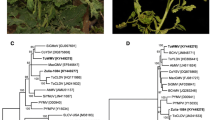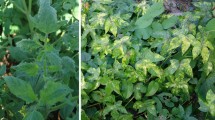Abstract
The incidence of tomato-infecting begomoviruses has sharply increased in Brazil following the introduction of the B biotype of the whitefly vector in the early 1990s. Five definitive species and six tentative species have been described since then. Here, we report the detection of members of an additional six novel species, three in tomato and three infecting weeds that are commonly associated with tomato fields: Blainvillea rhomboidea, Sida rhombifolia and Sida micrantha. Tomato and weed samples were collected in two major tomato-growing regions of southeastern Brazil in 2005 and 2007. Two of the novel viruses were present in tomato plants collected in Paty do Alferes, Rio de Janeiro state. Three novel viruses were present in weed samples collected in Coimbra, Minas Gerais state. One virus was present in tomato samples collected at both locations. Genome features indicate that all six species are typical New World, bipartite begomoviruses. However, the viruses belonging to two of the novel species did not cluster with the Brazilian viruses in a phylogenetic tree. These species could represent a distinct lineage of New World begomoviruses, found in Brazil for the first time.

Similar content being viewed by others
References
Andrade EC, Manhani GG, Alfenas PF, Calegario RF, Fontes EPB, Zerbini FM (2006) Tomato yellow spot virus, a tomato-infecting begomovirus from Brazil with a closer relationship to viruses from Sida sp., forms pseudorecombinants with begomoviruses from tomato but not from Sida. J Gen Virol 87:3687–3696
Calegario RF, Ferreira SS, Andrade EC, Zerbini FM (2007) Characterization of Tomato yellow spot virus, (ToYSV), a novel tomato-infecting begomovirus from Brazil. Braz J Agric Res 42:1335–1343
Dellaporta SL, Wood J, Hicks JB (1983) A plant DNA minipreparation: Version II. Plant Mol Biol Report 1:19–21
Faria JC, Souza-Dias JAC, Slack S, Maxwell DP (1997) A new geminivirus associated with tomato in the State of São Paulo, Brazil. Plant Dis 81:423
Faria JC, Maxwell DP (1999) Variability in geminivirus isolates associated with Phaseolus spp. in Brazil. Phytopathol 89:262–268
Fauquet CM, Briddon RW, Brown JK, Moriones E, Stanley J, Zerbini FM, Zhou X (2008) Geminivirus strain demarcation and nomenclature. Arch Virol 153:783–821
Fernandes AV, Galvão RM, Machado JJ, Zerbini FM, Fontes EPB (1999) Cloning and molecular characterization of A components of two new Sida rhombifolia-infecting geminiviruses. Virus Rev Res 4:148
Fernandes FR, Albuquerque LC, Giordano LB, Boiteux LS, Ávila AC, Inoue-Nagata AK (2008) Diversity and prevalence of Brazilian bipartite begomovirus species associated to tomatoes. Virus Genes 36:251–258
Fernandes JJ, Carvalho MG, Andrade EC, Brommonschenkel SH, Fontes EPB, Zerbini FM (2006) Biological and molecular properties of Tomato rugose mosaic virus (ToRMV), a new tomato-infecting begomovirus from Brazil. Plant Path 55:513–522
Ferreira SS, Fontes EPB, Zerbini FM (2005) Occurrence of begomoviruses and absence of satellite DNAs in weeds and tomato plants in Southeastern Brazil. In: 34th Annual Meeting of the Brazilian Society for Biochemistry and Molecular Biology (Abstracts on CD-Rom), Águas de Lindóia
Inoue-Nagata AK, Albuquerque LC, Rocha WB, Nagata T (2004) A simple method for cloning the complete begomovirus genome using the bacteriophage phi 29 DNA polymerase. J Virol Methods 116:209–211
Jovel J, Reski G, Rothenstein D, Ringel M, Frischmuth T, Jeske H (2004) Sida micrantha mosaic is associated with a complex infection of begomoviruses different from Abutilon mosaic virus. Arch Virol 149:829–841
Ribeiro SG, Ávila AC, Bezerra IC, Fernandes JJ, Faria JC, Lima MF, Gilbertson RL, Zambolim EM, Zerbini FM (1998) Widespread occurrence of tomato geminiviruses in Brazil, associated with the new biotype of the whitefly vector. Plant Dis 82:830
Ribeiro SG, Ambrozevicius LP, Ávila AC, Bezerra IC, Calegario RF, Fernandes JJ, Lima MF, Mello RN, Rocha H, Zerbini FM (2003) Distribution and genetic diversity of tomato-infecting begomoviruses in Brazil. Arch Virol 148:281–295
Ribeiro SG, Martin DP, Lacorte C, Simões IC, Orlandini DRS, Inoue-Nagata AK (2007) Molecular and biological characterization of Tomato chlorotic mottle virus suggests that recombination underlies the evolution and diversity of Brazilian tomato begomoviruses. Phytopathology 97:702–711
Rojas MR, Gilbertson RL, Russell DR, Maxwell DP (1993) Use of degenerate primers in the polymerase chain reaction to detect whitefly-transmitted geminiviruses. Plant Dis 77:340–347
Rojas MR, Hagen C, Lucas WJ, Gilbertson RL (2005) Exploiting chinks in the plant’s armor: evolution and emergence of geminiviruses. Annu Rev Phytopathol 43:361–394
Tamura K, Dudley J, Nei M, Kumar S (2007) MEGA4: molecular evolutionary genetics analysis (MEGA) software version 4.0. Mol Biol Evol 24:1596–1599
Zerbini FM, Andrade EC, Barros DR, Ferreira SS, Lima ATM, Alfenas PF, Mello RN (2005) Traditional and novel strategies for geminivirus management in Brazil. Aust Plant Pathol 34:475–480
Acknowledgments
This work was partially funded by CNPq grant 474140/2004–0 to FMZ. PAZ is a CNPq posdoctoral fellow. GPCU and JEAB were recipients of CAPES scholarships. AV is supported by the Carnegie Corporation of New York.
Author information
Authors and Affiliations
Corresponding author
Additional information
The sequences reported in this paper have been deposited in the GenBank under the accession numbers EU710749–EU710757.
Electronic supplementary material
Below is the link to the electronic supplementary material.
Rights and permissions
About this article
Cite this article
Castillo-Urquiza, G.P., Beserra, J.E.A., Bruckner, F.P. et al. Six novel begomoviruses infecting tomato and associated weeds in Southeastern Brazil. Arch Virol 153, 1985–1989 (2008). https://doi.org/10.1007/s00705-008-0172-0
Received:
Accepted:
Published:
Issue Date:
DOI: https://doi.org/10.1007/s00705-008-0172-0




